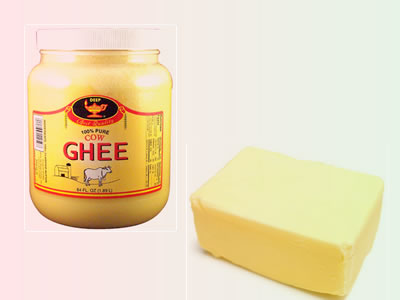Ghee is clarified butter, a butter with its water and milk solids removed, leaving almost-pure butterfat.
Ghee is considered to be a health food in Ayurveda. According to an Ayurvedic text, Bhavaprakasha, Ghee is “rejuvenating, good for the eyes and vision, kindles digestion, bestows lustre and beauty, enhances memory and stamina, increases intellect, promotes longevity, is an aphrodisiac and protects the body from various diseases”.
Modern studies have confirmed some of the benefits of ghee. Ghee is composed almost entirely of fat. Ghee is rich in Vitamin A and Vitamin D. It helps the absorption of not only vitamins and minerals but also phytonutrients. In one rodent study, ghee was shown to slightly reduce serum cholesterol. Studies in Wistar rats have found that ghee reduces plasma LDL cholesterol by increasing secretion of biliary lipids. 
One may argue that, these days, almost all health care professionals and doctors tell people to eat as less fatty foods as possible. Regular butter contains even less fat and is also rich in Vitamin A and Vitamin D, but butter is considered to be a contributor to health problems, especially heart disease. Why ghee is different? Ghee still is a butter, though it contains no water and milk solids, but it has even more fat than a regular butter does.
Let’s think about this: As the only difference between regular butter and ghee is containing or containing no water and milk solids, so if butter is a contributor to health problems (such as heart disease), then either the removed water and the milk solids cause the problems, or the remained fat and other ingredients cause the problems.
Why do you not tell people consume less water and milk that are removed from butter, but tell people eat less fat that is still contained in ghee?
Well, we cannot generally talk about whether a food is good or not good to our health without considering other factors. Why Ghee in some countries is considered to be a health food, but the similar product butter (that contains almost the same ingredients as ghee except water and milk solids) in the West is said to be a contributor to some health problems?
Let’s consider the difference in food and nutrition supply between a developing country and a developed country:
If in a country where people most time only have or even have no sufficient grains and vegetables to eat, and the high-fat foods such as meats, dairy products are only served for guests or for big days (such as festivals, birthdays, weddings), and some of the people even suffer from nutrient deficiencies and are malnourished, then ghee and butter definitely are nutritional foods and are good to people’s health.
If in a country where people consume too much meats, eggs, dairy products and sugar, and are fed by excessive high fat diet every day, and too many people are overweight, and too many people suffer from obesity, then eating less fatty foods, such as butter or ghee, is beneficial to their health.
One may ask a question: even in a developing country, there is a small number of rich people who can consume as much high fat foods as they want, but they still think ghee is good for their health and it seems that these high fat foods do not cause their health problems.
Whether butter or ghee causes less health problems in some developing countries than in a developed country, it needs more studies and statistics. But according to a study, World Health Day 2002 team of WHO, article “Heart disease and the young” by V. Radhika in The Week 27th December 1998:
– By the year 2020 India will have the largest cardiovascular disease burden in the world.
– One fifth of the deaths in India are from coronary heart disease. By the year 2020, it will account for one third of all deaths.
– Heart disease in India occurs 10 to 15 years earlier than in the west.
– There are an estimated 45 million patients of coronary artery disease in India.
According to a research published in The Lancet 2008, India will bear 60% of the world’s heart disease burden in the next two years. Compared to people in other developed countries, the average age of patients with heart disease is lower among Indian people and Indians are more likely to have types of heart disease that lead to worse outcomes.
There may be some people who consume much high fat foods and do not have heart disease. This may be due to the combination of their diet. In south Asia, people consume lot of spices, such as garlic, turmeric, chili peppers, ginger, black pepper, cumin, fenugreek, etc. These fat burning spices may reduce the negative effects of high fat foods.
So we can come to a conclusion: Is a food good or bad to your health, it all depends on your food and nutrition supply, depends on your health condition, whether your are overweight, or malnourished, and depends on the combination of your diet.
For more information about Ayurvedic remedies, go to Natural Remedies Center: http://www.naturalremediescenter.com/treat/ayurvedic-medicine/



